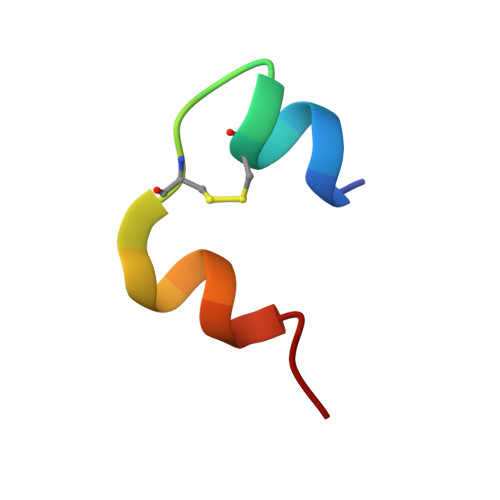Implications for the Active Form of Human Insulin Based on the Structural Convergence of Highly Active Hormone Analogues.
Jiracek, J., Zakova, L., Antolikova, E., Watson, C.J., Turkenburg, J.P., Dodson, G.G., Brzozowski, A.M.(2010) Proc Natl Acad Sci U S A 107: 1966
- PubMed: 20133841
- DOI: https://doi.org/10.1073/pnas.0911785107
- Primary Citation of Related Structures:
2WRU, 2WRV, 2WRW, 2WRX, 2WS0, 2WS1, 2WS4, 2WS6, 2WS7 - PubMed Abstract:
Insulin is a key protein hormone that regulates blood glucose levels and, thus, has widespread impact on lipid and protein metabolism. Insulin action is manifested through binding of its monomeric form to the Insulin Receptor (IR). At present, however, our knowledge about the structural behavior of insulin is based upon inactive, multimeric, and storage-like states. The active monomeric structure, when in complex with the receptor, must be different as the residues crucial for the interactions are buried within the multimeric forms. Although the exact nature of the insulin's induced-fit is unknown, there is strong evidence that the C-terminal part of the B-chain is a dynamic element in insulin activation and receptor binding. Here, we present the design and analysis of highly active (200-500%) insulin analogues that are truncated at residue 26 of the B-chain (B(26)). They show a structural convergence in the form of a new beta-turn at B(24)-B(26). We propose that the key element in insulin's transition, from an inactive to an active state, may be the formation of the beta-turn at B(24)-B(26) associated with a trans to cis isomerisation at the B(25)-B(26) peptide bond. Here, this turn is achieved with N-methylated L-amino acids adjacent to the trans to cis switch at the B(25)-B(26) peptide bond or by the insertion of certain D-amino acids at B(26). The resultant conformational changes unmask previously buried amino acids that are implicated in IR binding and provide structural details for new approaches in rational design of ligands effective in combating diabetes.
- Institute of Organic Chemistry and Biochemistry, Academy of Sciences of the Czech Republic, vvi, Flemingovo nám 2, 166 10 Prague 6, Czech Republic.
Organizational Affiliation:

















